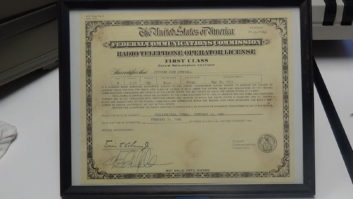Frequent readers of this column know that it occasionally finds an interest in chronology (such as the series on time zones in the Dec. 18, 2002 and Jan. 1, 2003 issues).
Perhaps the link may seem tenuous, but radio has always been a timekeeper of sorts for its listeners. Moreover, radio’s product exists solely in the temporal dimension — to the extent that its business model is based on the monetization of strictly measured periods of time. Such is the fundamental importance of time and its metrics to our industry.
So it’s appropriate to dip once again into the annals of human efforts to index the cycles of our planetary mechanics, and make them manageable for our daily life processes.
Time itself is an elusive concept, and while discovering its true nature keeps the physicists busy, its simple measurement is something the rest of us deal with all the time (no pun intended).
Since so many social and business processes depend on properly coordinated timing, a common understanding of time’s measurement processes worldwide is critical, as well.
Let me count the days
Early observations in time measurement were based on celestial movement of the sun, moon and stars.
Before TV, the sky won the viewership ratings every night (and attention spans were longer), so a pretty good understanding of these cycles eventually resulted.
In later times, humans developed devices and shortcuts that eliminated the need for direct, continuous celestial observation in order to “tell time,” but those early attempts provided the rough approximations that were later refined into the systems we have today.
The day and month were, of course, accommodations of the respective motions of the sun and moon, as observed by earthbound humans. Subdivisions of the day into hours, minutes and seconds came later. Today we have the ability to globally synchronize this chronometry down to a fraction of a second.
This doesn’t just involve technology, of course — it also requires political agreement to use the same scales and a common reference.
Such coordination and true synchronization of worldwide time is a relatively recent development, starting only in the late 19th century. Previously, each town or region set its own time, based on local solar observation, the master reference for which was kept by the closest clock tower. Like many other similar processes, such preference for localism was strongly held, and in this case ultimately gave way only for reasons of public safety (to avoid train collisions, for one thing).
You might be surprised to learn that a similar common reference for the counting of days was also a struggle to achieve, and only came about relatively recently, as well.
The coordinated agreement worldwide on today’s date hearkens back to the 16th century, but it was not globally accepted until much later in some countries — even the U.S. It’s actually quite a story …
A non-integral relationship
As noted above, celestial observations had reached relatively high accuracy even in ancient times, and by the time of the Roman Empire, a calendar that accurately accommodated days, weeks and months had been developed.
This Roman calendar served as the basis of all the Western calendars that followed, even up to today. It was of the same general structure as our current calendar in terms of months, although it originally began its year on April 1. (Our April Fool’s Day is an artifact of this change.)
The length of the solar year did not cooperate with any such reckoning, however, given its duration that was not evenly divisible by the other units. This caused any fixed calendar to gradually slip against the seasons, and given the importance of agriculture at the time, this was not happily accepted.
The Romans had made numerous attempts to correct for this discrepancy, but none of them really solved the problem consistently until in 45 BCE, Julius Caesar adopted a system devised by the astronomer Sosigenes of Alexandria that added a leap year on the 29th of February in every fourth year.
This so-called Julian calendar was promulgated by the Romans (whose empire was at the peak of its influence at the time), and eventually served as a near-globally uniform calendar for many centuries thereafter.
The average length of the Julian year was 365.25 days, but even this was a bit off from the actual solar (or “mean tropical”) year’s length of 365.24219 days.
Thus even the Julian calendar eventually suffered some seasonal shift, and so in 1582, a calendar developed by an Italian doctor and astronomer named Aloysius Lilius was published in a papal bull issued by Pope Gregory XIII.
It made a small but important change to the Julian calendar that allowed it to remain synchronized more closely to the true solar year on average, by making every year ending in 00 (which would normally be a leap year) not be a leap year, except for those divisible by 400, which would remain leap years. Thus 1600 and 2000 were leap years, but 1700, 1800 and 1900 were not.
The other, more interesting element of the Gregorian calendar was its attempt to correct for the seasonal shift that had accumulated during recent use of the Julian calendar. It accomplished this by simply “canceling” 10 days.
(Lilius had originally proposed a gradual correction by skipping the leap days every leap year for 40 years, but the pope preferred immediate gratification, and ordered the quick fix instead.) So Thursday Oct. 4, 1582 was followed by Friday Oct. 15, 1582 — the first day of the Gregorian calendar’s use.
Great trivia question: What happened on Oct. 5, 1582? Answer: Nothing! (The day didn’t exist, nor did the 6th through 14th — except as noted below, where it really gets historically interesting.)
Politics über alles
Remember when I mentioned the importance of political will to achieving international consensus? Well, the fact that the Gregorian calendar was sponsored by a pope meant that it had effect on the Catholic Church’s ecclesiastical calendar, but no impact upon the civil calendars of any country without being adopted by local governments.
Naturally, this took some time to organize, but the situation was made worse by the alignment of various countries toward or against the Catholic religion, which was seen as the new calendar’s developer and champion.
As it turned out, only four countries (Spain, Portugal, most of Italy and the Polish-Lithuanian Commonwealth — all Catholic) adopted the Gregorian calendar on its origination day in October 1582, with a few other countries — and somewhat later, their colonies — coming on board in the next several months.
Many non-Catholic countries resisted the Gregorian calendar, some keeping to their old calendars for many decades, but eventually, all joined the fold.
For example, most of Scandinavia and the Protestant states of Germany converted in 1700, with Britain and its Empire (including the American colonies) switching over in 1752. By then, the sync-error correction needed to be larger (the Julian year 1700 had been a leap year), so these countries canceled 11 days upon adoption.
Thus the dates Sept. 3 to Sept. 13, 1752 do not exist in U.S. history. Russia didn’t change until 1918, the year following its revolution, and Greece finally adopted the Gregorian calendar in 1923, when it jumped from Wednesday, Feb. 15 to Thursday, March 1.
Of course, there were plenty of local exceptions and variations along the way. One of the most interesting was Sweden, which opted to use Lilius’ original idea of a gradual, 40-year correction when it converted in 1700, but realized after a few years of following this course that it would be out of sync with its neighbors for a long time to come, and still not fully correct the seasonal drift problem until the transition was completed, while suffering plenty of confusion in the meanwhile.
For some reason, though, the Swedish king decided that the proper fix was to return to the Julian calendar in 1712. Ultimately, Sweden made a second transition to the Gregorian calendar, this time with an overnight switch (from Feb. 17 to March 1) in 1753.
Alaska presented another interesting anomaly. It converted after its 1867 purchase from Russia (still on Julian calendar at the time) by the U.S., but instead of the appropriate 12-day conversion at the time, only 11 days were skipped because the (then recently instituted) International Date Line was moved on the same day from its original position at the state’s eastern boundary to offshore on the west of the state — the new U.S.-Russian border.
Historians obviously have a heck of a time figuring out valid dates in the various countries given all this variation. This also implies that the trivia question above needs to be fixed to a location (“What happened in Rome on Oct. 5, 1582?”).
Next time you think keeping time is boring, look into its fascinating history to see how what we take for granted today actually came about. It’s a great example of humanity’s ability — or at least its attempts — to apply order to its environment.











